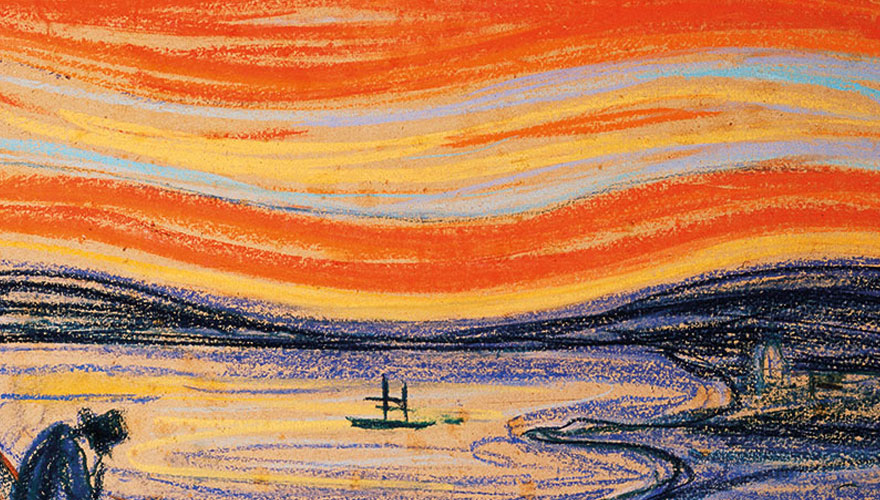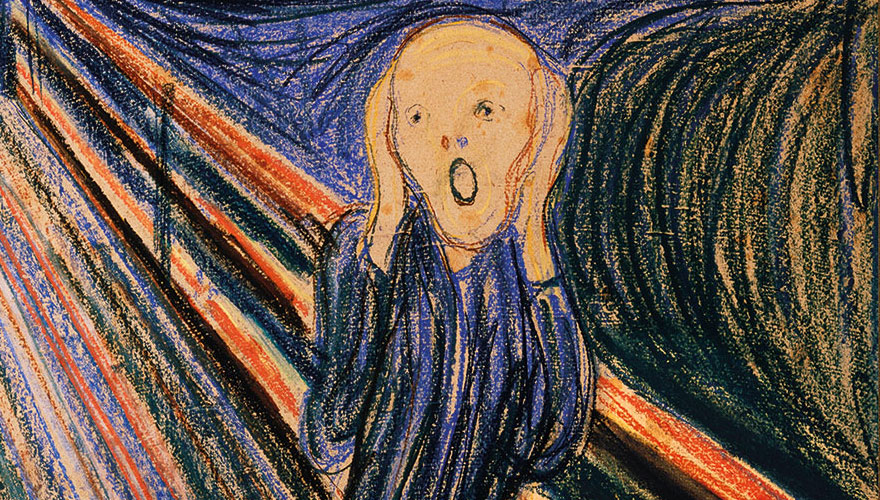
Edvard Munch "The Scream" - Myth and Milestone of Art History
There are a few works in the history of art that have achieved notoriety far beyond the world of art and have virtually achieved cult status. These rare, exceptional works include Leonardo da Vinci's "Mona Lisa", Andy Warhol's "Campbell's Soup Cans", and Edvard Munch's "The Scream". This iconic motif of a figure standing on a bridge in front of a blood-red sky, holding its hands to its head with its mouth wide open, has been firmly established in the collective memory for decades. Munch painted a total of four versions of the famous scene using different techniques and sizes. In addition, he created a lithograph. In doing so, he altered the motif slightly in terms of the colour scheme and the pictorial composition. Three of the four paintings can be seen in different museums; the fourth version was sold in 2012 for 120 million dollars, making it the most expensive painting in the world at that time.
The well-known picture "The Scream" is today considered a key work of Expressionism. Its main motif has been reproduced, quoted, and modified countless times over the past decades in the various fields of pop culture: Andy Warhol, for example, made screenprints of the scene, and the motif has been translated three-dimensionally into sculptures, such as by Jochen Bauer, and it is printed on media such as postcards, posters, or T-shirts. The successful horror movie series "Scream" obviously used Munch for the protagonist's mask, and the painting even served as a model for an emoji. These various homages to the "Scream" picture prove that the motif, which will soon be around 130 years old, still captivates many people today.
"The Scream" - The Picture, It's Meaning and History(s) of Its Creation
Edvard Munch painted the first version of the motif in 1893. However, to this day it has not been definitively clarified what ultimately inspired him to paint this work. Therefore, there are many theories about the picture "The Scream" and its meaning: One of them says that Munch let his own spiritual life flow into this motif and that he brought his inner pictures onto the canvas. The gloomy mood of the scene would have been quite typical for him, for he had processed his difficult life story in many of his paintings. He had lost his mother and sister at an early age and struggled with depression and alcohol addiction throughout his life. Consequently, Munch could have expressed his fears and despair in the desperate figure of "The Scream". In contrast, other theories on the genesis of the painting assume purely external influences. Some art historians see a resemblance to a mummy in the central figure. They explain this by the fact that Munch saw Inca mummies at the World's Fair in Paris in 1889 and was inspired by the constricted bodies.
The Glowing Sky: Volcanic Eruption or Mother-of-Pearl Clouds?
There are always new interpretations and explanations even for the red, orange, and yellow glowing sky in the picture "The Scream". The theory that Munch was inspired by a natural spectacle that had its origins in a volcanic eruption is frequently put forward. In 1883, Krakatoa erupted in Indonesia and catapulted large quantities of ash and dust into the stratosphere. The dust clouds spread worldwide and are said to have been responsible for glowing red sunsets for many years to come. Edvard Munch may have once seen this sky because he wrote: "The sky suddenly turned blood-red. (...) There was blood and tongues of fire above the blue-black fjord and the city." Therefore, it does not seem entirely unreasonable that he had been influenced by this discolouration of the sky.

Also referring to the luminous sky are the considerations of Norwegian meteorologists, who, however, take a completely different approach. The reason for the discolouration of the sky was not the volcanic eruption but another natural phenomenon, the so-called mother-of-pearl clouds. This phenomenon, which is meteorologically correctly called "polar stratospheric clouds", can only be observed in high latitudes (such as Norway). This phenomenon is very rare. The higher the sun rises in the morning or sinks in the evening, the more intense and brilliant the colours of the clouds become. It will never be possible to conclusively clarify whether it was a celestial event and if Munch even was inspired by it. It is highly possible that Munch painted the picture from his memories anyway and thus - entirely in the spirit of later Expressionism - allowed his personal impressions and his emotional world to flow into the painting.
"The Scream" and Its Interpretation: An Enigmatic Inscription and a Supposedly False Picture Title
In addition to the conjectures about the origin of Edvard Munch's "The Scream", there are numerous other interpretations and analyses surrounding this legendary work of art. Two research results, in particular, have caused a furore in recent years. One investigation dealt with the picture's title, the other with a mysterious inscription.

There had never been any serious doubts about the connection between the painting's title and its motif. Obviously, the person in the painting was screaming, which was also unmistakably evident from the painting's name. In 2019, however, the British Museum presented a completely different interpretation. According to the art historians, the person was not screaming at all, but rather hearing a scream. The deciding factor for this interpretation was a note that Munch had left on a preparatory work. "I felt the great scream through nature," it says. This suggests that the protagonist's mouth was open in fright and that he was covering his ears. However, the scholars do not provide any proof of whether Munch actually heard the scream or an explanation of where it might have come from.
For a long time, a barely visible pencil inscription on the first version of the picture from 1893 also caused puzzlement. "Could only have been painted by a madman!" it says in Norwegian, and it was completely unclear who and when it came from. In 2021, the National Museum in Oslo reported that Munch had most likely written the sentence on the painting himself. This was confirmed by comparisons of the handwriting of the phrase with Munch's diaries and letters. However, one can only guess about his intention. One assumption is that it was an ironic comment by Munch on public speculation about his state of mind.
Many of the questions surrounding Edvard Munch's "The Scream" have already been answered, but the myth of this milestone in art history lives on and will probably inspire the imagination of many generations to come.
